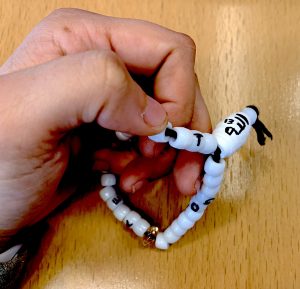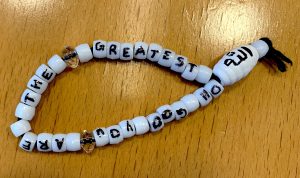

Week 8: Sufi Piety I – Shaykhs, Pirs, Music, Dance and Poetry
Fourth Project (3D/Jewelry):
In class, there have been a plethora of examples of the Islamic experience; these experiences can manifest in different ways— specifically we’ve learned music, poetry, and dance. However, in learning all these art forms as an experience of Islam through the lens of the creator, there are physical tangible objects to help others experience Islam. In reflecting on what other ways one can experience Islam, I thought of rosaries. Religiously, rosaries are an integral part of physical actions (practice) within multiple religions. In Sufism, it is more prevalent to see music and poetry because of its familiarity, “Popular appreciation of Sufism today frequently focuses on music and dance, which in our public culture are much more familiar categories than prayer or metaphysics,” (Ernst 179). Specifically, I wanted to create a piece that is functional, but one that can also serve as another demonstration of a religious experience— pertaining to Islam.
This class has addressed multiple perspectives of experiencing religion and in week 8 this pertained to primarily Sufism— a way of practicing Islam, experientially and this way of understanding Islam has existed for a long time, “Sufi practice and doctrines are the very essence of Islam,” (Asani/Lecture 10/31). I would like to address week 8 before examining a different experience of religion, the piece I created. In understanding the religious preface of these different experiences, those of music, poetry, etc., they are present religion and different perspectives (Asani/Lecture 10/29). During this week we learned about how music and poetry bring light to the experience that Sufi’s practice. In fact, these two concepts are an integral part of practicing Islam as a Sufi. In introducing my piece, I contradict this way of practice, yet, compliment because of the methodology. I contradict this way of practice by presenting something that is relatively more conservative from a societal aspect. However, I compliment it by connecting this piece to zikr— a way of devoting to God.
I wanted to shed light on a practical religious practice that relates to experiencing the day to day life of being a Muslim. Depicted above is a rosary that I created. At the top of the rosary shows a bead with “Allah” painted in Arabic. Throughout the thirty-three beads, are the words “Oh God, You are The Greatest.” Essentially these beads, present this notion of continual remembrance of God— an experiential practice. This can be related to the idea of zikr in which Sufis chant God related phrases in unison. Thus, this piece effortlessly demonstrates how religious practice can be related to Sufism in which we addressed week 8.